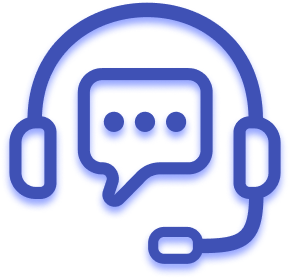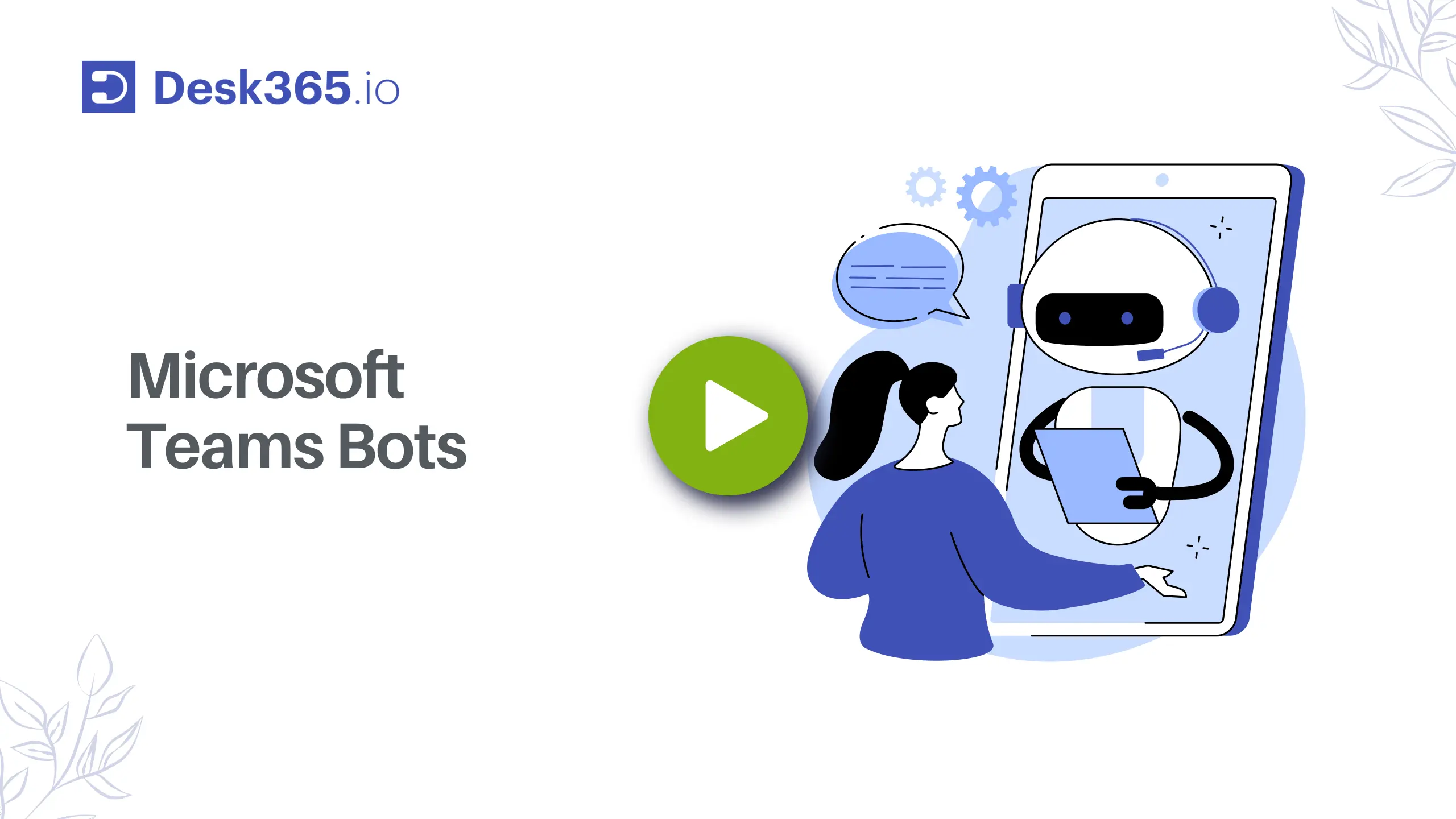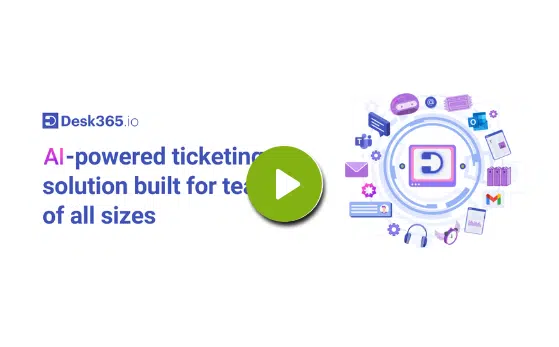A recent survey found that 69% of customers prefer solving problems on their own, while 80% expect businesses to be available around the clock.
With customers demanding quick, convenient solutions, it’s no wonder that more companies are turning to customer service automation to keep up.
From AI-powered chatbots that can answer questions instantly, to self-service portals that let customers find solutions without waiting on hold, automation is transforming how businesses interact with their customers. In fact, Forrester Research found that 63% of companies using AI for customer service saw a boost in customer satisfaction.
And it’s not just about making customers happy—it’s also about improving efficiency, reducing response times, and cutting costs. As automation continues to evolve, it’s quickly becoming a must-have for businesses that want to stay competitive and deliver the seamless, on-demand service customers expect.
What is customer service automation?
Customer service automation is all about using technology to handle customer support tasks that would otherwise require a human touch.
Various types of AI agents can be employed in this process, each specializing in different aspects of customer service.
Imagine you’re running a business, and a customer has a simple question like, “Where’s my order?” Instead of waiting for a customer service agent to look it up, automation can take care of it instantly. A chatbot could check the order status and give the customer a real-time update, 24/7.
It’s not just for answering questions, either. Automation can streamline processes like routing customer tickets to the right department, scheduling appointments, or even recommending products based on a customer’s past purchases. Essentially, it’s about reducing the workload for your human team while giving customers faster and often more consistent support.
The goal isn’t to replace humans entirely but to handle repetitive tasks so your support agents can focus on the more complex, personal, or high-value interactions that really matter. Think of it as a partnership between technology and your customer service team, working together to make the customer experience as smooth and efficient as possible.
Why automate customer service?
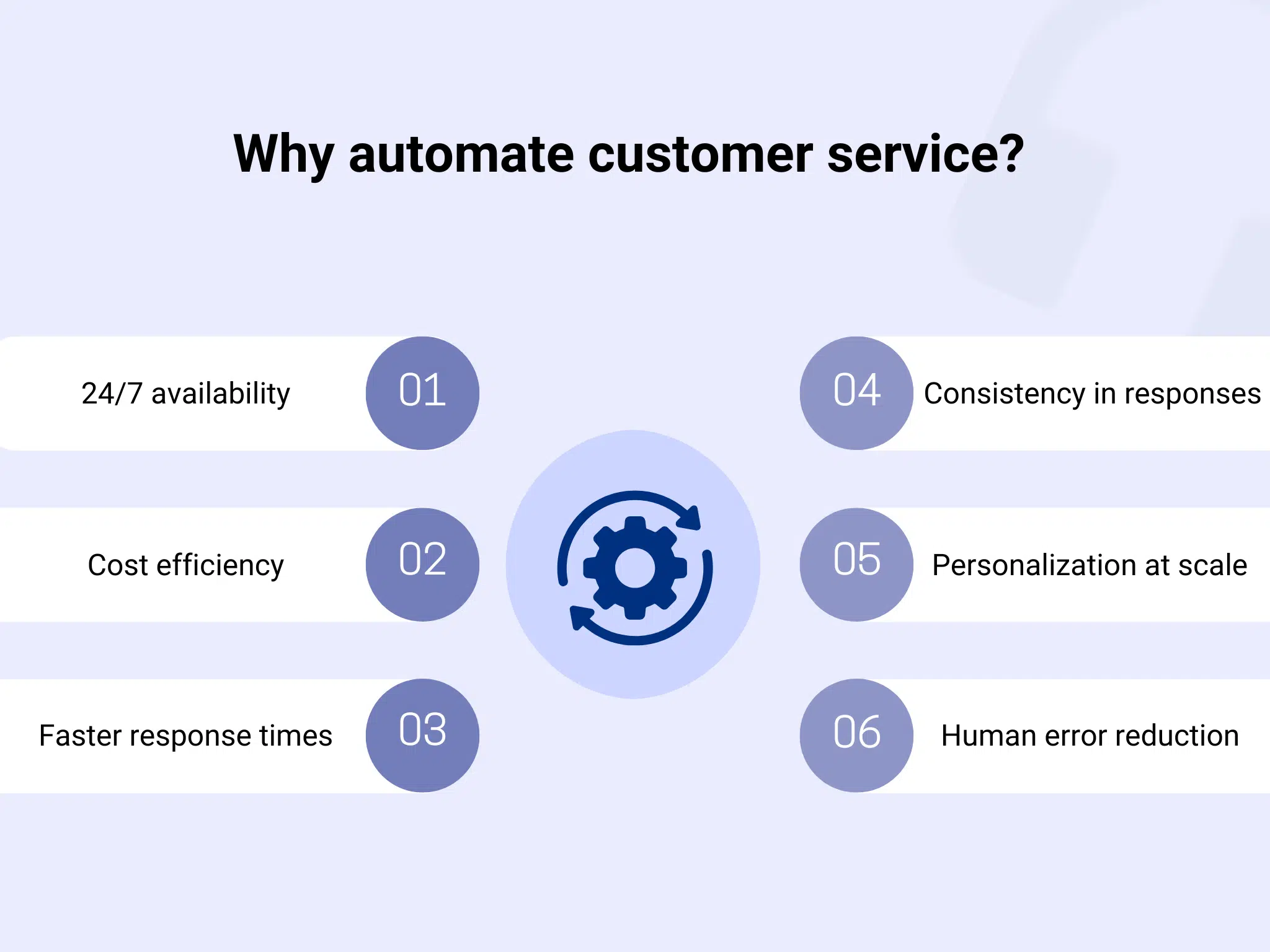
Automating customer service can offer a wide range of benefits for businesses and customers alike. At its core, the goal of automation is to streamline operations, improve customer experiences, and reduce costs while maintaining or enhancing service quality. Here’s a more detailed look at why automating customer service makes sense in today’s business environment:
1. 24/7 availability
One of the biggest advantages of automation in customer service is the ability to offer around-the-clock support. Customers no longer have to wait until business hours or struggle with time zone differences. Whether it’s answering basic questions, resolving simple issues, or providing information, automation ensures that help is available any time of day or night. This convenience can significantly improve customer satisfaction, especially in a global marketplace where customers expect instant responses.
2. Cost efficiency
Automating routine tasks can significantly reduce operational costs. By offloading repetitive and low-level queries to chatbots or automated systems, businesses can free up human agents to focus on more complex issues that require emotional intelligence or nuanced problem-solving. This leads to better resource allocation, where human agents are used for tasks that truly require their expertise, while automation handles the bulk of standard inquiries.
3. Faster response times
Customers today expect quick solutions, and automation can help provide that. Whether it’s an FAQ chatbot, an automated phone system, or a self-service portal, customers can get instant answers without waiting in long queues. This can help reduce frustration and increase customer loyalty. Automated systems can handle high volumes of queries simultaneously, which can prevent bottlenecks that often occur during peak times.
Read more – How to improve customer response time?
4. Consistency in responses
Automated systems are programmed to provide consistent, accurate answers based on pre-determined rules or data. This reduces the risk of human error, and ensures that all customers receive the same high-quality response. Whether it’s a billing inquiry or a troubleshooting guide, automation ensures that customers get the same information each time, leading to fewer misunderstandings and better customer trust.
5. Personalization at scale
While automation may seem impersonal at first glance, modern systems can be designed to personalize customer interactions. For example, AI-driven chatbots can use customer data to offer tailored recommendations, anticipate needs, or provide personalized offers. By analyzing past interactions, automated systems can provide relevant solutions that feel personal, even if they are delivered at scale. Multimodal AI takes this a step further by integrating text, images, and sounds to improve personalized recommendations.This combination of efficiency and personalization can lead to higher customer satisfaction.
6. Improved data collection and insights
Automated systems can gather valuable data during customer interactions that can be used for business insights. Every chat, phone call, or interaction provides data about customer preferences, pain points, and satisfaction levels. This data can be analyzed to improve products, services, and even future customer service interactions. By leveraging automation, businesses can gain real-time insights into customer behavior and quickly adapt to changing needs.
7. Scalability
As businesses grow, it can become increasingly difficult to maintain the same level of customer service with a growing number of staff. Automation provides a scalable solution that can easily handle spikes in demand without the need to hire additional employees. Whether it’s seasonal fluctuations, promotions, or unexpected surges, automated systems can accommodate increased interaction volume without compromising service quality.
8. Proactive customer support
Automation can not only react to customer inquiries but can also be used to proactively reach out to customers. For example, automated systems can send reminders, follow-up emails, or notifications about potential issues before they arise, helping customers feel cared for and preventing problems from escalating. Proactive support can improve the customer experience by addressing potential concerns before they even have a chance to reach the customer
9. Globalization and multilingual support
Automation also makes it easier to offer multilingual support, which is essential for global businesses. Chatbots or automated systems can be set up to communicate in multiple languages, allowing businesses to provide consistent customer service to international customers without the need for an extensive multilingual support team.
10. Human error reduction
Humans, no matter how skilled, can make mistakes. With automation, businesses can minimize the risk of errors in repetitive tasks. Whether it’s processing orders, updating account details, or managing ticket queues, automation ensures that tasks are completed according to the set rules, with far less risk of oversight or miscommunication.
11. Increased customer loyalty and retention
Ultimately, the goal of any business is to foster positive relationships with its customers. Automation, when done correctly, can enhance the overall customer experience by providing faster, more reliable, and personalized service. Happy customers are more likely to return, refer others, and stay loyal to a brand. By reducing wait times, offering consistent service, and addressing issues efficiently, automation can help businesses build stronger customer relationships over time.
How does automated helpdesk work?
Here’s a deeper dive into how automation works in customer service.
1. Ticket creation
When a customer reaches out—whether via submitting a form, engaging in Microsoft Teams, or sending an email—Desk365 automatically generates a ticket. This ticket includes key information, such as:
- The customer’s identity.
- The source of the interaction (e.g., Microsoft Teams, email, web form).
- The ticket should be directed to the appropriate team member or department based on predefined rules or automation.
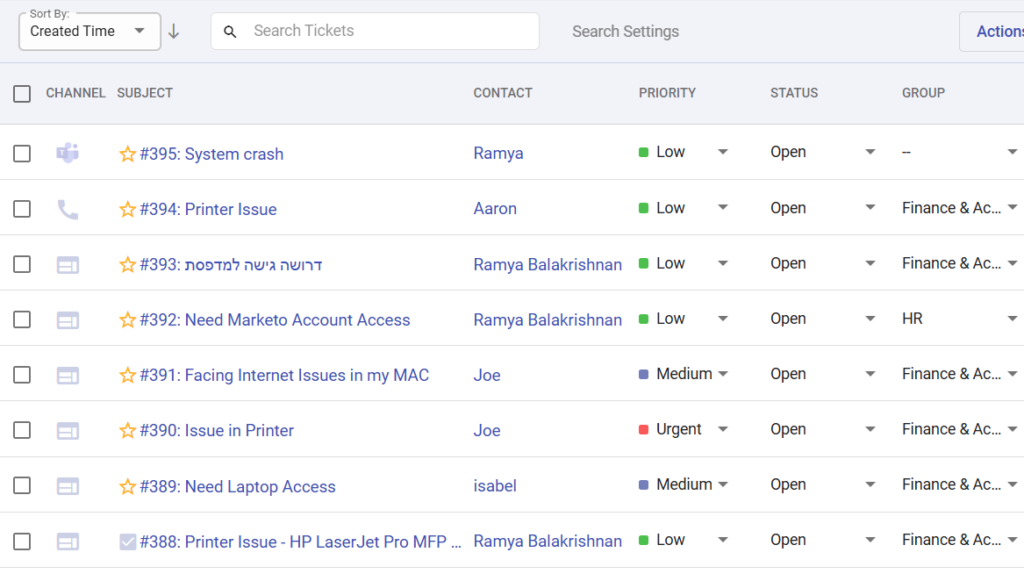
2. Routing and assignment
Once the ticket is created, Desk365 uses automated routing rules to assign the ticket to the right support agent. This ensures that no issue is overlooked and that customers receive timely responses from the right person or team.
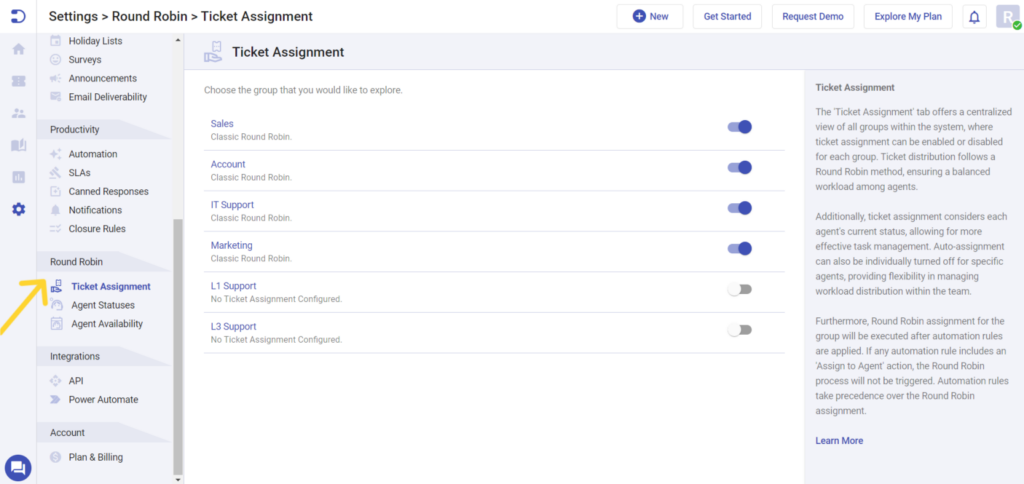
Read more – Automate Ticket Assignment using Round Robin
3. Data and reporting
After the customer’s issue is resolved, Desk365 automatically compiles data on the ticket, such as:
- Ticket volume.
- Response time.
- Resolution time.
This data gives the support team valuable insights into their performance and helps identify areas for improvement.

Automated customer service includes a range of components, each designed to improve the efficiency and quality of customer support. Some examples are:
Read more – Productivity reports in Desk365
What are some examples of automated support?
Customer service automation is transforming the way support teams operate, allowing businesses to deliver faster and more efficient support while improving the overall customer experience.
Imagine you decide to implement an automated helpdesk system, such as Desk365. This tool enables your customer service team to efficiently record, organize, and track all customer tickets or issues through a centralized dashboard. The dashboard is fully accessible to the entire team, allowing for smooth collaboration and transparency.
1. Automated ticketing systems
When a customer submits a query or support request, automated ticketing systems generate a support ticket, assign it to the appropriate team or agent, and notify the customer with updates throughout the process. This reduces the need for manual sorting and routing of requests, ensuring that each inquiry is handled in a timely manner.
a. Automated ticket creation
When a customer submits an inquiry via Microsoft Teams, email, live chat, or even social media, the system automatically creates a support ticket and prioritizes it based on urgency or customer type.
Automation rules for ‘Ticket Creation’ in Desk365 let you automate various tasks to simplify your customer support process. Here are some simple examples:
- Assigning tickets to specific agents based on ticket properties like category or priority.
- Setting ticket properties such as priority, type, status, and category.
- Updating the ticket status to ‘Waiting for Vendor’ or ‘On Hold’ based on specific criteria.
- Routing tickets to specific teams or departments based on their content or properties.
- Deleting tickets based on specific conditions and more.
b. Ticket routing and assignment
Based on predefined rules, tickets can be automatically routed to the appropriate department (e.g., billing, technical support) or assigned to agents based on workload or expertise.
c. SLA (Service Level Agreement) monitoring
Automated systems can track whether tickets are being resolved within agreed-upon time frames, escalating them to higher-priority status if necessary.
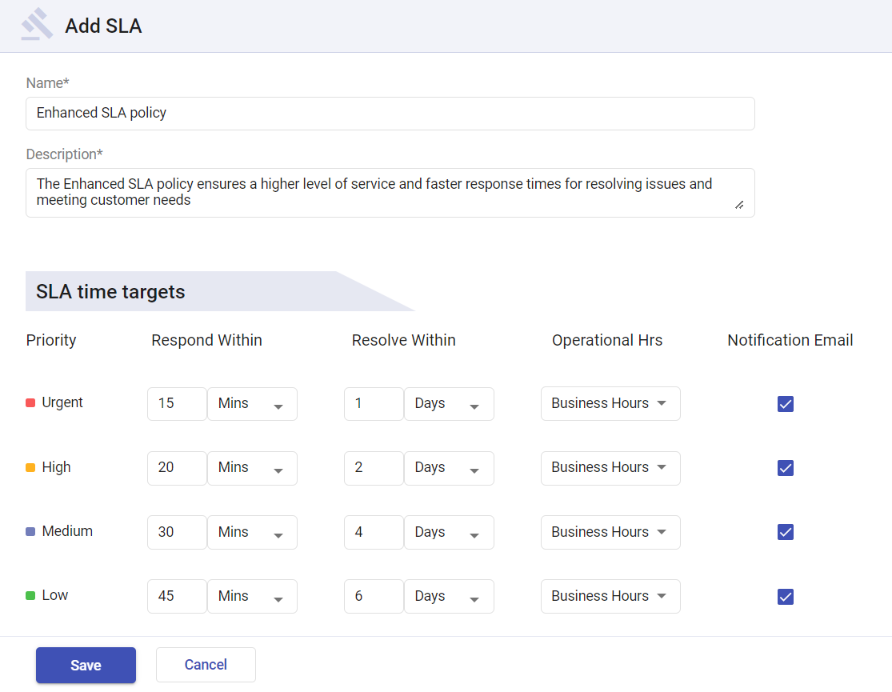
2. Self-service portals
Many businesses offer self-service portals where customers can find answers to their questions without needing to interact with a human agent. These portals may include FAQs, video tutorials, troubleshooting guides, and knowledge bases, all of which are powered by automation.
Establishing a knowledge base within your helpdesk can significantly enhance the efficiency and effectiveness of your customer support team. Ideally, your knowledge base should cover all key aspects of your product or service that customers are likely to seek assistance with.
Knowledge base automation
Self-service portals can automatically suggest articles based on the customer’s query or browsing history.
Dynamic FAQs
FAQs can be automatically updated based on trends in customer inquiries, ensuring that the most relevant information is always available.
Personalized suggestions
Using machine learning, the portal can recommend articles, tutorials, or even community forum posts based on the customer’s previous interactions or account history.
3. AI chatbots
Chatbots are one of the most common forms of automated support. These AI-powered tools can engage with customers through websites, messaging apps, or social media platforms. Chatbots can respond to frequently asked questions (FAQs), guide users through troubleshooting steps, and even handle simple transactions like booking appointments or processing refunds
Natural Language Processing (NLP)
Chatbots can understand and respond to customer queries in natural, conversational language.
Contextual understanding
Advanced bots can track the context of a conversation, remembering prior interactions to provide more accurate and personalized responses.
Self-service options
Bots can provide self-service support, like guiding users through account management or helping them find answers from a knowledge base.
5. Workflow automation
Many businesses use automated workflows to streamline and speed up internal processes like onboarding, issue resolution, and ticket escalation. These workflows ensure that tasks are completed efficiently and consistently.
Automated task assignments
Once a ticket is submitted, workflows can automatically assign tasks to different departments or agents, depending on the complexity or type of request.
The Round Robin ticket assignment system in Desk365 ensures that tickets are correctly distributed among support agents. The feature streamlines ticket assignments by automating the process, ensuring a balanced distribution of workload among support agents
Escalation rules
If a ticket isn’t resolved within a certain timeframe, automated workflows can escalate the issue to a senior agent or higher priority level.
Desk365 simplifies ticket escalation with its robust, cloud-based platform, designed to handle your customer service needs with ease. With Desk365, you can set up automated escalation workflows based on factors like wait times, priority, and issue complexity. This ensures that urgent issues are swiftly escalated to the right agents or teams, helping you meet SLA targets and boost First Response Time (FRT).
Customer segmentation
Automated workflows can segment customers based on their behavior or interaction history, delivering tailored support or marketing communications.
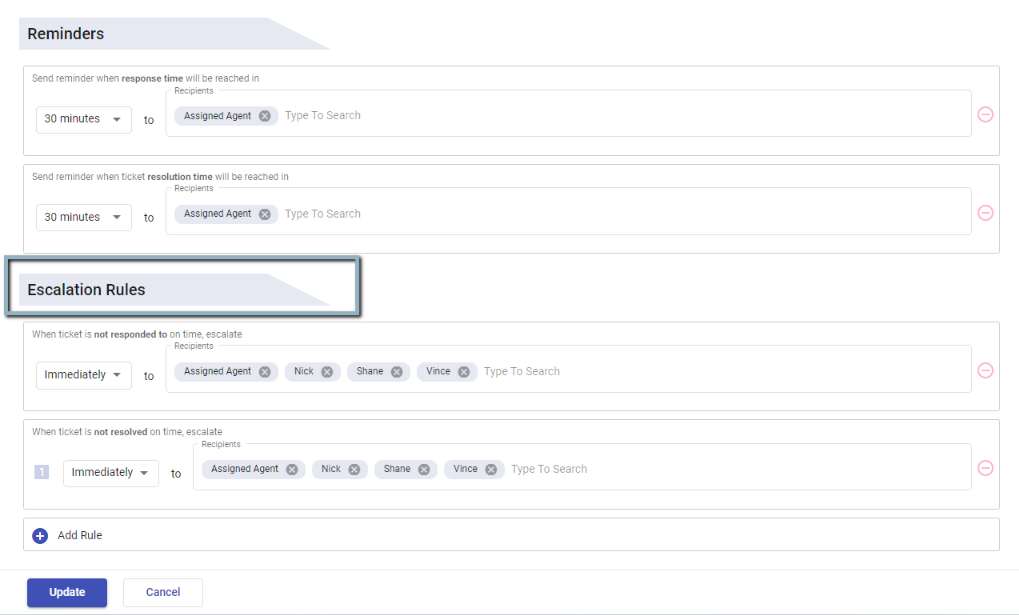
6. Customer survey feedback
Set up automated customer feedback surveys—such as NPS (Net Promoter Score), CSAT (Customer Satisfaction), and CES (Customer Effort Score)—to gather valuable insights that can help improve the customer experience. By leveraging NPS tools, you can efficiently collect and analyze customer feedback data to identify areas for improvement and make data-driven decisions.
These surveys can be automatically triggered at the right moments, allowing customers to provide feedback after completing key actions, such as making a purchase, interacting with a support rep, or finishing a service call. By automating the timing of these surveys, you ensure that you collect feedback at critical touchpoints, enabling your team to make data-driven decisions to enhance service quality and customer satisfaction.
Read more – Create and send customer surveys from Desk365
Best automated customer service software in 2025
If you’re seeking the best tools to automate your customer service, check out some of the software options we’ve listed below
1. Desk365
Desk365 delivers a robust cloud-based ticketing system, known for its user-friendly interface and seamless implementation. Packed with features like efficient ticket management, collaborative tools for teams, automation, and SLA capabilities, Desk365 empowers businesses to optimize their customer support operations, guaranteeing swift attention and resolution for every ticket.
Shared inbox
One of the most useful features of ticketing software is its shared inbox. With Desk365, you can have a shared inbox which allows multiple team members to access and manage customer tickets from a unified centralized interface. It helps to ensure that no emails are missed or overlooked and that all customer inquiries are responded to promptly. Furthermore, Desk365 offers omnichannel support, which seamlessly consolidates customer conversations from various channels into the shared inbox.
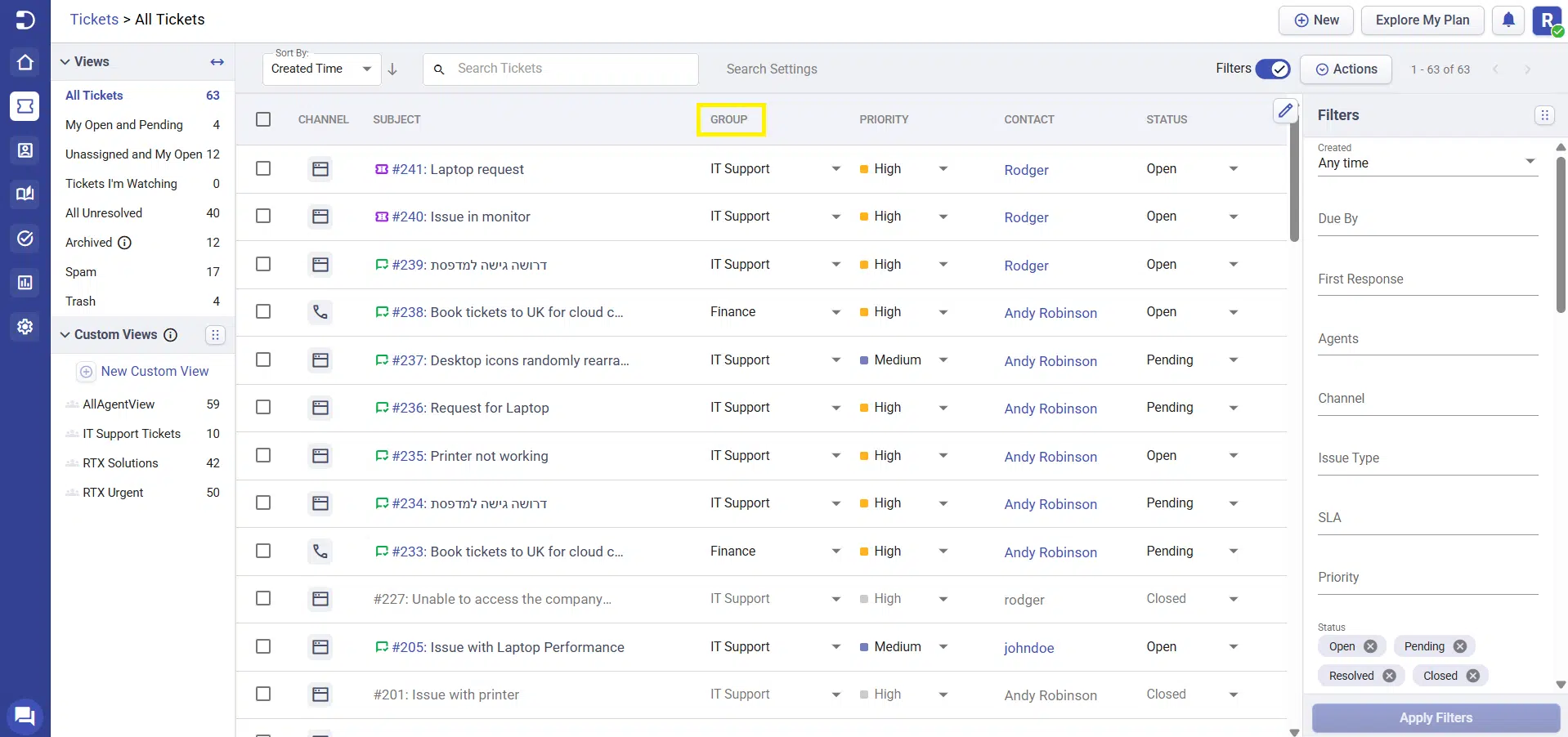
Ticket creation and assignment
Utilizing Desk365, you can effortlessly assign emails to designated individuals or teams, ensuring that customer inquiries are directed to the most suitable person. When a customer submits an inquiry through email, Desk365’s email ticketing system seamlessly transforms it into a ticket. The system captures vital details, including the customer’s contact information, issue description, and any relevant attachments. Subsequently, the ticket is assigned to a suitable support agent for resolution.

Ticket categorization and prioritization
Desk365 allows you to categorize tickets based on the nature of the enquiry or the product/service involved. This helps support teams to prioritize and allocate resources accordingly. By assigning different levels of priority, urgent issues can be addressed promptly, preventing any potential escalations. This helps to ensure that customer enquiries are handled in the most appropriate manner.
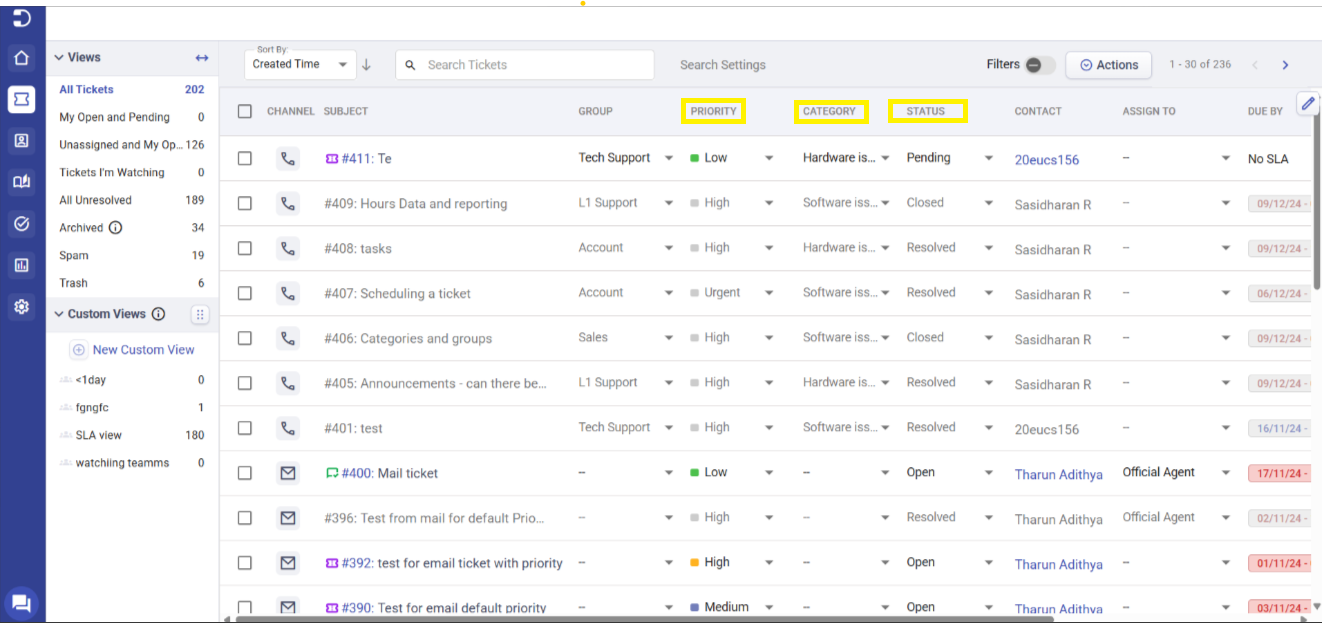
Ticket tracking and escalation
Desk365 allows support agents to track the progress of each ticket from submission to resolution. This ensures transparency and accountability throughout the support process. In cases where a ticket requires escalation to a higher-level support agent or supervisor, our system provides an easy mechanism for such escalations.
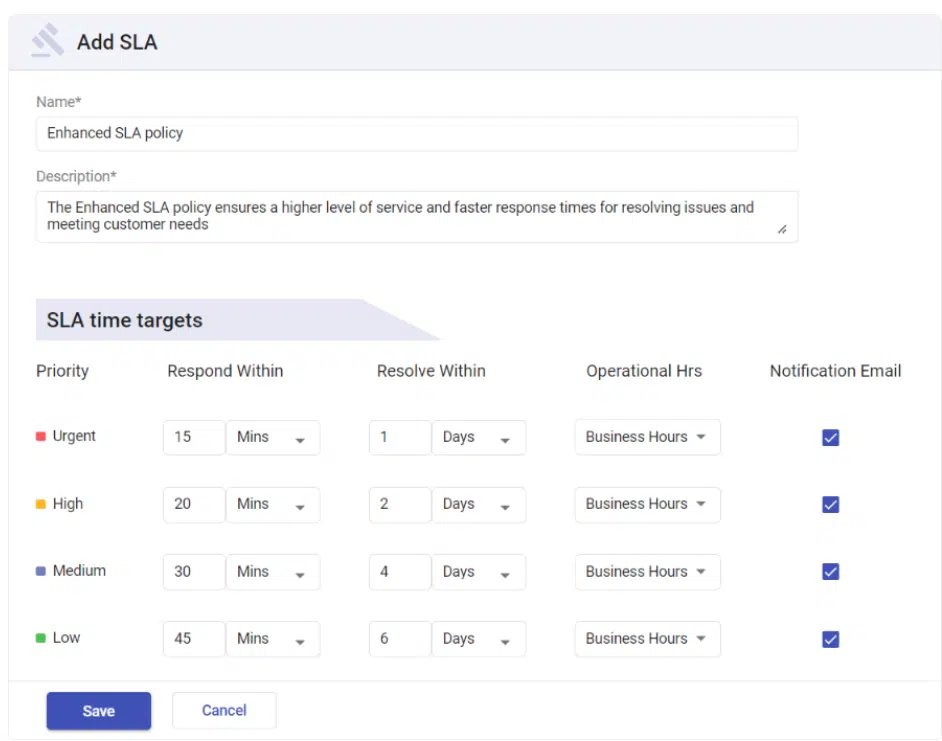
You can configure SLA rules to send reminders before the Response Time and Resolve Time are reached. Also, you can configure escalation rules that specify when and who to notify in case of SLA violations.
Collaborating on tickets
Collaboration is an important aspect of Desk365. It allows team members to work together on customer issues, discuss the issue using private notes and comments, and provide feedback. This helps to ensure that all team members are on the same page and that customer conversations are handled efficiently and effectively. This promotes knowledge sharing and enhances problem-solving capabilities.
Automation capabilities
Desk365’s automation feature allows teams to automate repetitive tasks such as assigning tickets, sending notifications, setting SLAs, and more. This helps to save time and increase efficiency, allowing team members to focus on more important tasks.
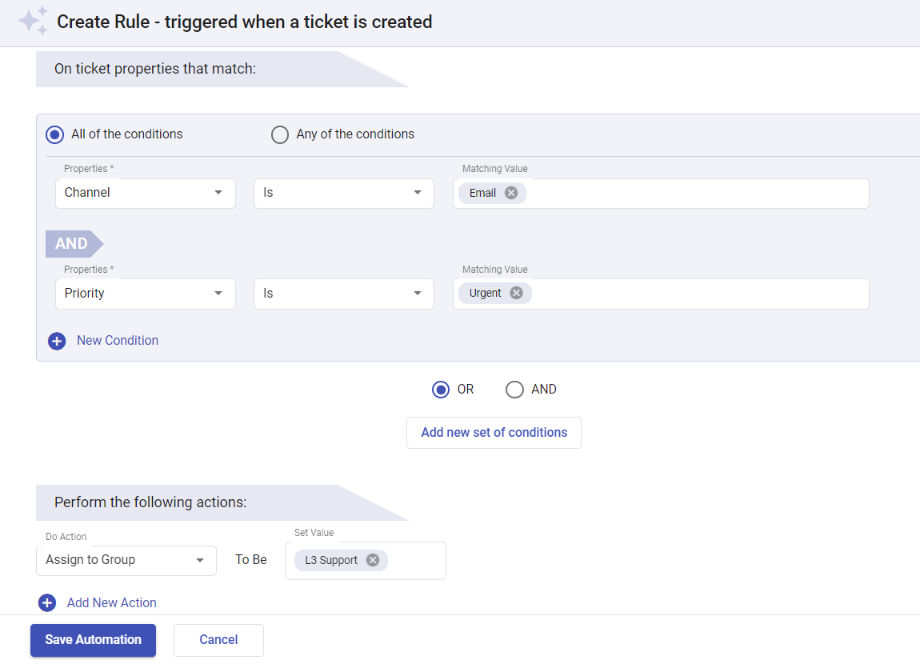
Reporting and analytics
Desk365 provides valuable insights through reporting and analytics features. Using Desk365, teams can track key metrics such as response times, resolution times, and customer satisfaction. This helps to identify areas for improvement and ensure that customer enquiries are handled effectively. Managers can access data on ticket trends, response times, resolution rates, and customer satisfaction metrics. These insights enable businesses to identify areas for improvement, optimize support workflows, and make data-driven decisions.
CSAT surveys
Desk365’s CSAT surveys are a valuable feature that allows teams to gather feedback from customers and measure their satisfaction levels. This helps to identify areas for improvement and ensure that customer needs are being met. With Desk365, you can easily create and send CSAT surveys to customers and track their responses in real-time.
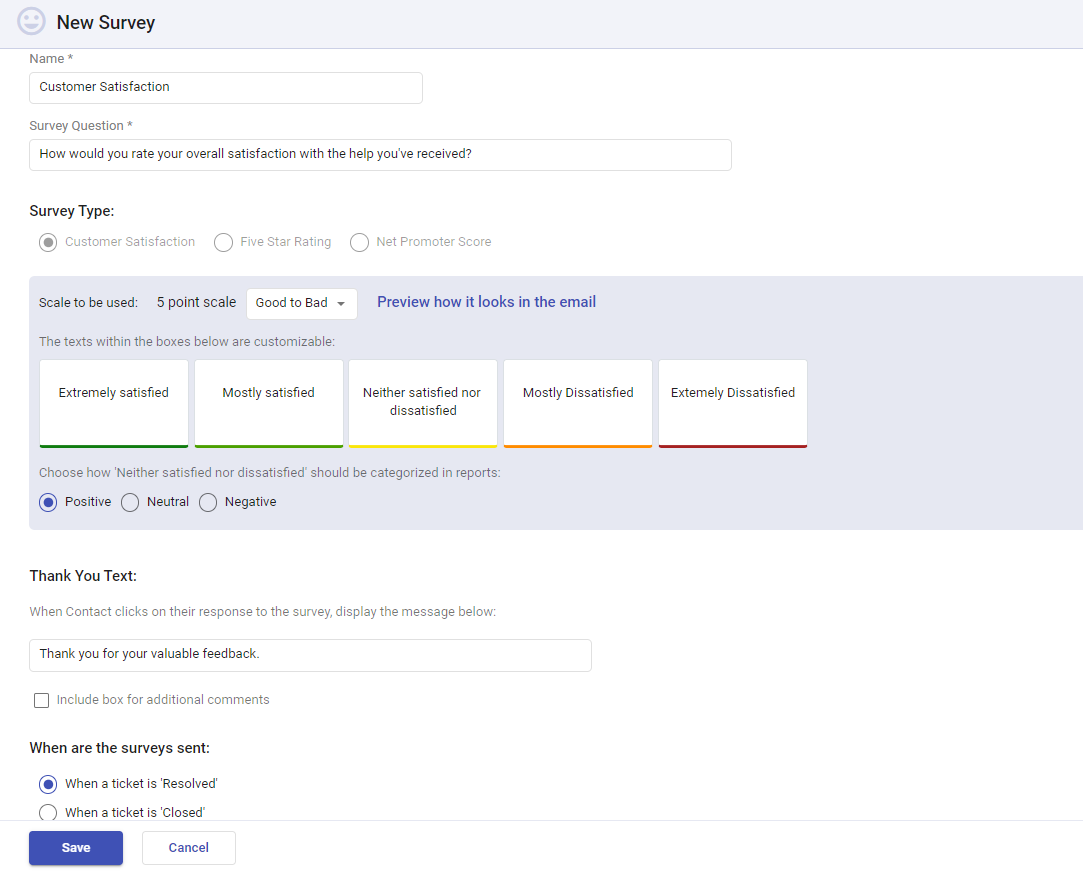
Email templates
Desk365’s email templates are a useful feature that allows teams to create pre-written responses to common customer enquiries, saving time and increasing efficiency. With our canned responses feature, you can create and save templates for frequently asked questions, common issues, and more. This helps to ensure that responses are consistent and accurate, and that customers receive timely and helpful support.
Check out: 13 tips for writing customer service email effectively.

Collision detection
Desk365’s collision detection features notifies team members when multiple people are working on the same ticket. This helps to prevent duplication of effort and ensure that customer enquiries are handled efficiently. With our collision alert feature, team members can avoid stepping on each other’s toes and work collaboratively to resolve customer issues.
Pricing:
Lowest Paid Plan: $12/agent/month
Highest Paid Plan: $20/agent/month
Free trial available.
2. Freshdesk
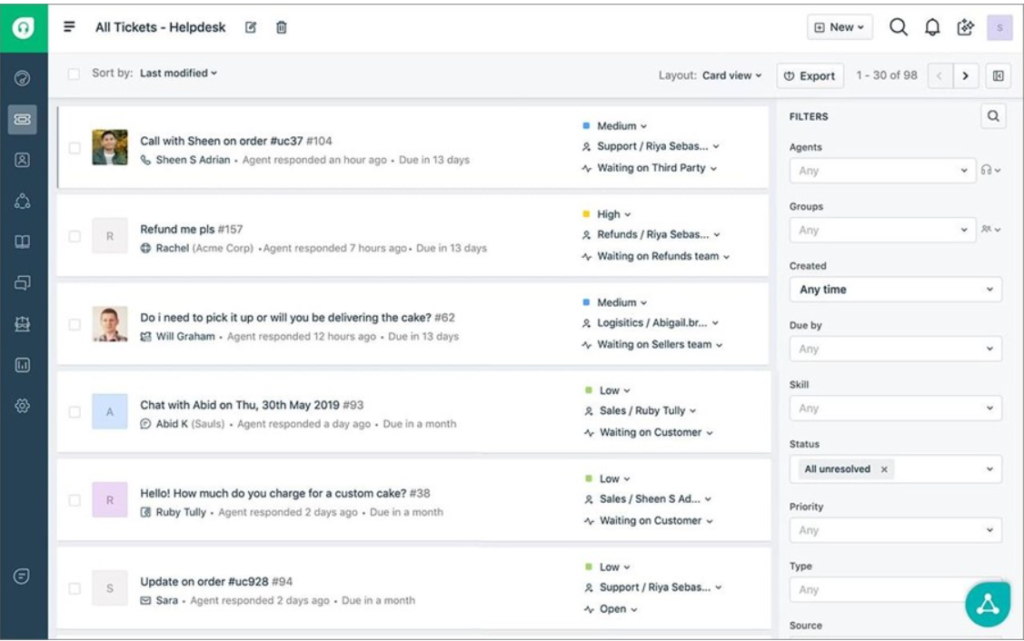
Freshdesk, often compared with Zendesk, is a comprehensive customer support software developed by Freshworks Inc. It’s designed to streamline customer service processes and improve the quality of support provided by businesses across various industries. Freshdesk offers a multitude of features aimed at enhancing customer experience and boosting the efficiency of support teams.
Recommended Reading – 13 Best Freshdesk Alternatives for Businesses for 2024
Freshdesk features
- Ticket management
- Zia AI Assist
- Self-service
- Agent productivity
- Customization
Pricing
- Growth: $15/agent/month
- Pro: $49/agent/month
- Enterprise: $79/agent/month
3. Zoho Desk
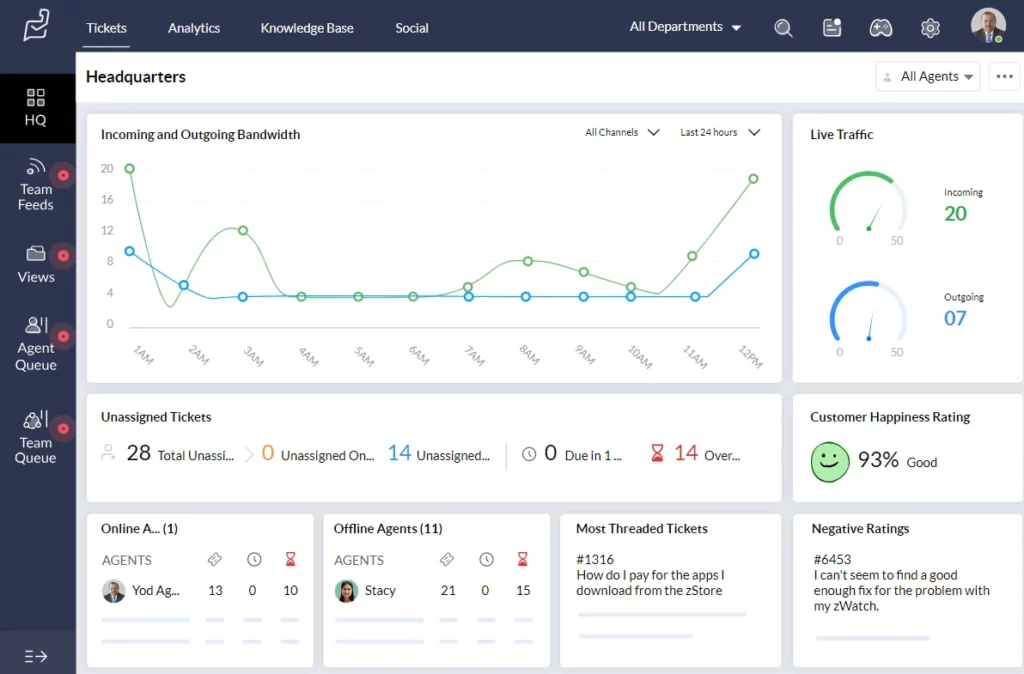
Zoho Desk, often compared with Zendesk is a cloud-based customer service software designed to help businesses manage their customer support activities efficiently. As a part of the Zoho ecosystem, which includes a wide range of business and productivity tools, Zoho Desk integrates seamlessly with other Zoho applications as well as third-party systems. Here’s what makes Zoho Desk stand out:
Recommended Reading – Best Zoho Desk Alternatives for Businesses in 2024
Zoho Desk features
- Customization
- Ticket management
- Omnichannel
- Automation
- Analytics
Pricing
- Standard: $14/user/month
- Professional: $23/user/month
- Enterprise: $35/user/month
4. Zendesk
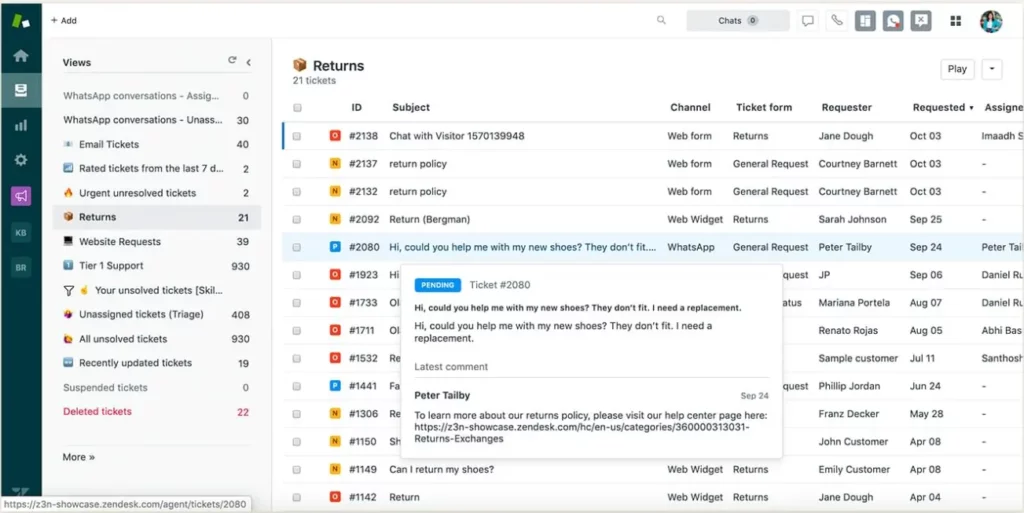
Zendesk, often compared with Help Scout is a powerful customer service software that caters to businesses looking for a robust, scalable solution to manage their customer interactions. Known for its flexibility and comprehensive set of features, Zendesk allows companies to build better customer relationships through streamlined communication and improved support services. This platform stands out in the Zendesk review landscape as a top choice for businesses looking to elevate their customer experience with efficiency and customization.
Recommended Reading – Best Zendesk Alternatives in 2024
Zendesk features:
- Multi-channel support
- Advanced ticketing system
- Automation and workflows
- Customizable interfaces
- Reporting and analytics
- Integrations with other business tools
- Knowledge base and self-service options
- Live chat capabilities
- AI and machine learning enhancements
- Security and compliance measures
Read more – Zendesk Features [+Pros and Cons Breakdown]
Pricing
- Suite team: $55/agent/month
- Suite growth: $89/agent/month
- Suite professional: $115/month/ user
Read More – Zendesk Pricing: Does it offer value for money?
Different types of customer service automations
Desk365 offers a wide range of automation features that help streamline workflows, improve response times, and enhance customer experience. Below are some powerful automation options you can implement using Desk365:
1. Automating ticket assignment using round-robin
Round-robin ticket assignment is a powerful feature in Desk365 that automatically distributes incoming tickets evenly across your support team, ensuring fair workload distribution and preventing any agent from being overwhelmed. This feature is especially useful in environments where quick responses are critical, such as in technical support or customer service teams with high ticket volumes.
When a new ticket comes in, Desk365 assigns it to the next available agent in a pre-set, circular order. This ensures that every ticket has a dedicated team member, minimizing response delays and improving customer satisfaction. With this round-robin system, Desk365 helps your team handle a large number of tickets efficiently, while ensuring that no single agent is overburdened with work.
2. Automate communication with ticket requester
Desk365 makes it easier to communicate directly with customers through its Ticket Requester feature. By setting up automation rules, you can trigger automatic emails based on a variety of conditions—such as ticket status, issue type, or customer location—keeping customers informed without manual effort.
For example:
- When a ticket is submitted, an automatic acknowledgment email can be sent to the customer.
- If the status of the ticket changes (e.g., from “Pending” to “Resolved”), an automated email can be triggered to notify the requester.
- If a high-priority issue arises, the system can send a tailored email to the customer, reassuring them that their query is being escalated and prioritized.
This automation helps businesses maintain timely and personalized communication, making customers feel valued and reducing manual outreach efforts from support agents.
When a new ticket comes in, Desk365 assigns it to the next available agent in a pre-set, circular order. This ensures that every ticket has a dedicated team member, minimizing response delays and improving customer satisfaction. With this round-robin system, Desk365 helps your team handle a large number of tickets efficiently, while ensuring that no single agent is overburdened with work.
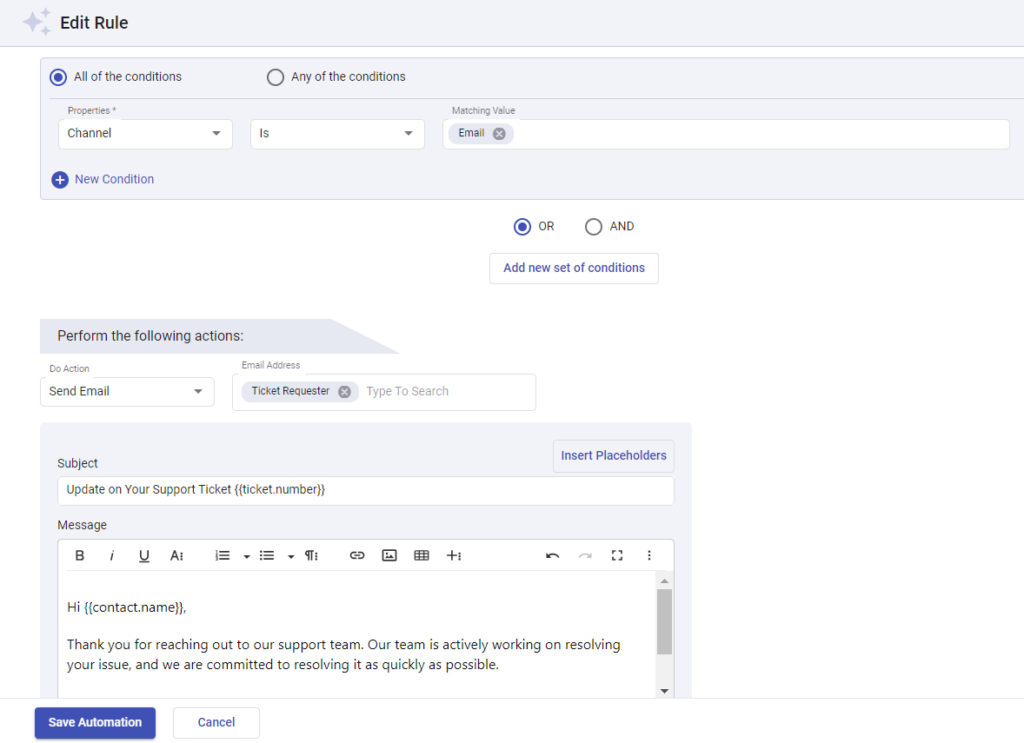
3. Time-based triggers for ticket management
Time-based triggers in Desk365 allow you to automate actions based on a specific time frame, saving time and improving overall efficiency in helpdesk operations. This automation is ideal for managing SLAs and ensuring that no ticket is left unresolved for too long.
For example:
- Escalating unresolved tickets: If a ticket has not been responded to within a set timeframe, a time-based trigger can automatically escalate it to higher-level support for faster resolution.
- Sending reminder emails: If a ticket remains inactive for a certain period, an automatic reminder can be sent to the assigned agent to follow up or take action.
- Auto-closure: Tickets that have been resolved and not updated in a while can be automatically closed after a set period, ensuring the support dashboard remains organized and clutter-free.
This feature helps ensure critical issues don’t slip through the cracks, improving response times and reducing the risk of SLA breaches.
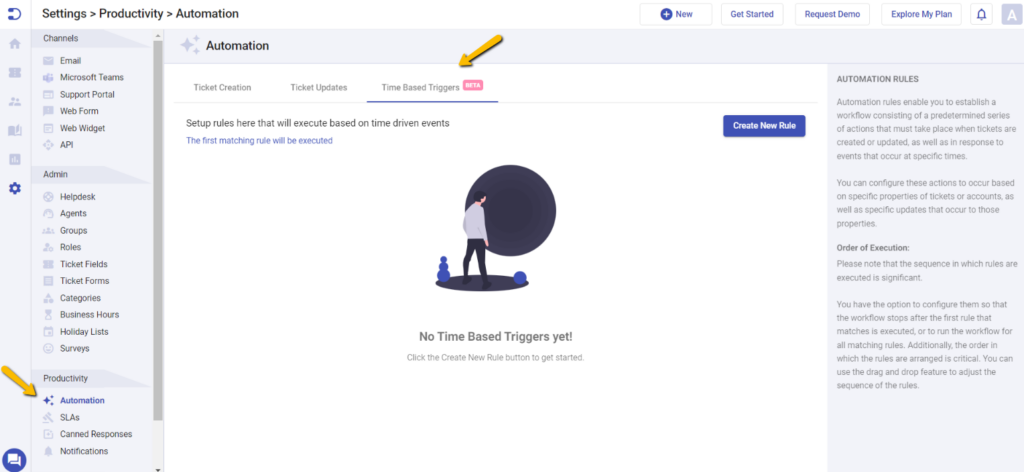
4. Automatically assign tickets based on the ticket form
Using custom ticket forms in Desk365, businesses can categorize tickets based on the specific information provided by the customer. Automating ticket assignment based on these forms ensures that tickets are directed to the appropriate department or team, improving efficiency and response times.
For example:
- An IT support form could automatically trigger the assignment of the ticket to the IT support team.
- A Marketing inquiry form could direct tickets to the marketing team for specialized handling.
- A Billing and payments form could route tickets directly to the finance team.
By categorizing tickets through forms and setting up specific automation rules, Desk365 ensures that agents receive all the necessary details upfront, reducing the need for additional clarifications and enabling quicker resolutions. This automation also minimizes human error in ticket routing, ensuring that each team handles only the tickets relevant to their area of expertise.
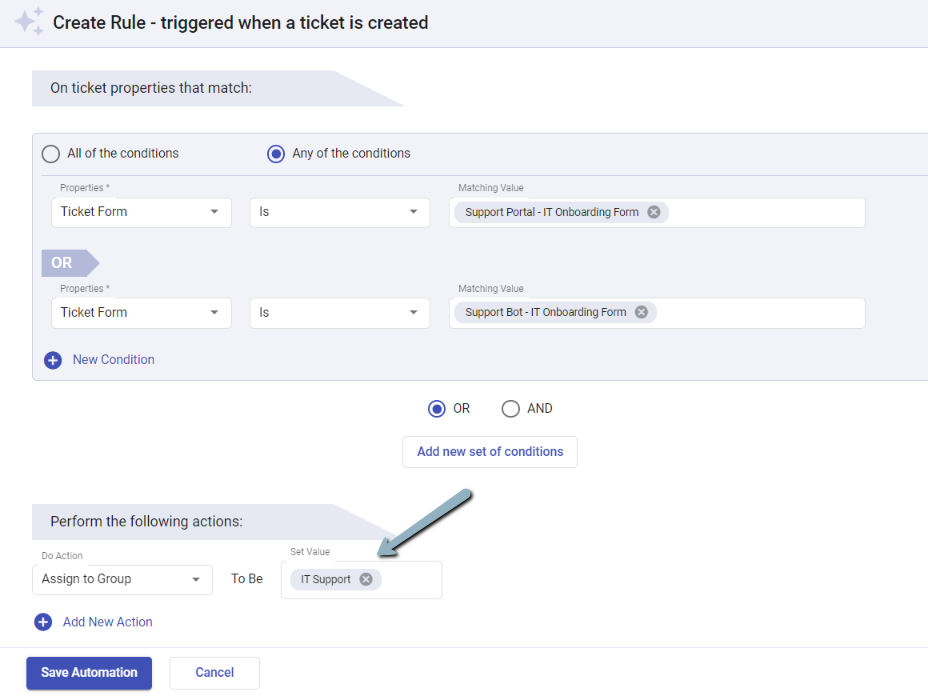
In summary, customer service automation is changing the game for businesses. It helps handle routine tasks quickly, gives customers faster responses, and frees up human agents to focus on more complex problems. While it’s not a replacement for personal interaction, it’s a great tool to make support more efficient and reliable. By combining automation with a human touch, companies can create a better, smoother experience for their customers.


